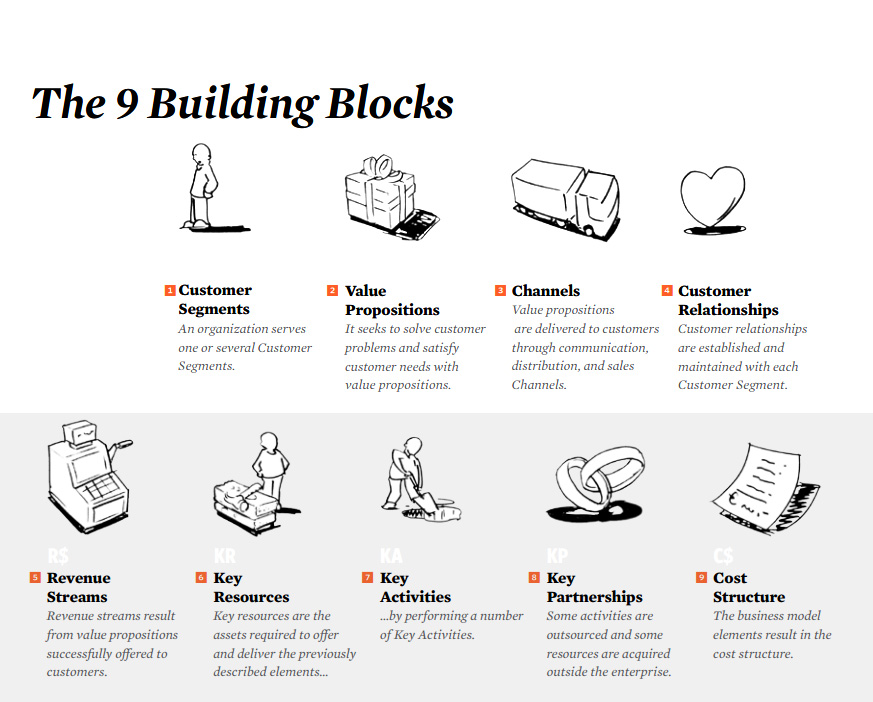In the world of business strategy, the Business Model Canvas by Alexander Osterwalder and Yves Pigneur has become a cornerstone for organizations aiming to articulate their value creation, delivery, and capture mechanisms.
But how does this framework intersect with user experience (UX) design? As a Senior UX Designer with over two decades of experience, I’ve seen firsthand how aligning UX principles with these nine building blocks can drive innovation, customer loyalty, and profitability.
This post will dissect each component of the Business Model Canvas, infuse it with UX insights, and illustrate how businesses can leverage design thinking to optimize their models. Let’s dive in.
#1: Customer Segments – Designing for the Right Audience
Business Perspective:
Customer segments define who an organization serves. These groups vary based on needs, profitability, and distribution channels. Examples include:
- Mass Segments: Broad audiences (e.g., consumer electronics).
- Niche Markets: Tailored solutions (e.g., enterprise SaaS tools).
- Multi-Sided Platforms: Interdependent groups (e.g., Uber serves riders and drivers).
UX Lens:
Understanding customer segments is akin to crafting user personas and conducting user research. For instance:
- Airbnb segments travelers (seeking unique stays) and hosts (seeking income), each requiring distinct UX flows.
- Netflix tailors its interface to casual viewers vs. binge-watchers, using algorithms to personalize content.
Actionable Insight:
Use tools like surveys, interviews, and analytics to map user needs. Platforms like Hotjar or UserTesting can reveal pain points across segments.
Further Reading:
#2: Value Propositions – Solving Problems Through Design
Business Perspective:
Value propositions answer why customers choose your offering. Elements include:
- Performance: Faster, better solutions (e.g., Tesla’s electric vehicles).
- Customization: Tailored experiences (e.g., Nike By You).
- Convenience: Streamlined processes (e.g., Amazon’s 1-Click ordering).
UX Lens:
A strong value proposition is rooted in user-centered design. For example:
- Apple’s emphasis on minimalist design and usability differentiates it in crowded markets.
- Slack transformed workplace communication by reducing friction with intuitive channels and integrations.
Actionable Insight:
Conduct journey mapping to identify pain points. Tools like Figma or Miro can visualize these insights.
Further Reading:
#3: Channels – Optimizing Touchpoints for Seamless Journeys
Business Perspective:
Channels dictate how value reaches customers. These include:
- Direct (e.g., e-commerce websites) vs. Indirect (e.g., retail partners).
- Phases: Awareness (social media ads), Purchase (checkout flows), After-Sales (support portals).
UX Lens:
Channels are the user touchpoints in a customer journey. Consider:
- Starbucks integrates its app (direct channel) with mobile ordering, rewards, and pickup.
- Warby Parker blends online try-ons with physical stores for a hybrid experience.
Actionable Insight:
Audit channels for consistency. A/B test landing pages or checkout flows using Optimizely.
Further Reading:
#4: Customer Relationships – Building Trust Through Design
Business Perspective:
Relationships drive acquisition, retention, and sales. Types include:
- Self-Service: FAQs, chatbots (e.g., Spotify’s help center).
- Personalized Assistance: Dedicated account managers (e.g., B2B SaaS platforms).
UX Lens:
UX shapes trust and loyalty. For example:
- Zappos uses empathetic customer service (live chat, returns) to build loyalty.
- Duolingo employs gamification (streaks, rewards) to retain users.
Actionable Insight:
Implement CRM systems like Salesforce, but ensure their interfaces are user-friendly for both employees and customers.
Further Reading:
#5: Revenue Streams – Designing for Monetization
Business Perspective:
Revenue streams answer what customers pay for. Models include:
- Subscription (Netflix), Freemium (Spotify), or Transaction Fees (eBay).
UX Lens:
Pricing psychology and transparency are critical. For example:
- LinkedIn Premium uses tiered pricing with clear benefits.
- Robinhood disrupted finance with commission-free trading (simplified UX).
Actionable Insight:
Test pricing pages with tools like UsabilityHub to minimize friction.
Further Reading:
#6: Key Resources – Aligning Assets with UX Goals
Business Perspective:
Resources include physical (factories), intellectual (patents), and human (talent).
UX Lens:
Invest in UX teams, design systems, and tools like Sketch or Adobe XD. Example:
- Google’s Material Design system ensures consistency across products.
Actionable Insight:
Audit internal tools for UX efficiency. Poorly designed CRMs can hinder employee productivity.
Further Reading:
#7: Key Activities – Designing Processes That Deliver Value
Business Perspective:
Activities include production, problem-solving, and platform management.
UX Lens:
Streamline workflows with service design. For example:
- IKEA’s self-assembly model reduces costs while empowering users.
Actionable Insight:
Map internal processes with Service Blueprints to identify inefficiencies.
Further Reading:
#8: Key Partnerships – Collaborating for Better UX
Business Perspective:
Partnerships include suppliers, alliances, or joint ventures.
UX Lens:
Third-party integrations must be seamless. Example:
- Shopify’s app ecosystem allows merchants to add features without coding.
Actionable Insight:
Test API integrations for usability. Poorly designed partner tools can frustrate users.
Further Reading:
#9: Cost Structure – Balancing UX and Budget
Business Perspective:
Costs can be fixed (salaries) or variable (cloud hosting).
UX Lens:
Invest in high-impact areas. For example:
- Canva reduced design costs with templated tools for non-designers.
Actionable Insight:
Use ROI calculators to justify UX investments (e.g., reduced support tickets).
Further Reading:
Conclusion: The Symbiosis of Business Models and UX
The Business Model Canvas isn’t just a strategic tool—it’s a blueprint for designing experiences that resonate. By aligning each building block with UX principles, businesses can create value that’s both sustainable and user-centric. Whether you’re a startup or an enterprise, remember: great business models are built on great experiences.
Additional Resources:
- Business Model Generation by Osterwalder & Pigneur
- NN/g: UX Best Practices
- Harvard Business Review: Business Models
By weaving UX into the fabric of your business model, you’ll not only meet customer needs but exceed them—driving growth in an increasingly experience-driven economy.


